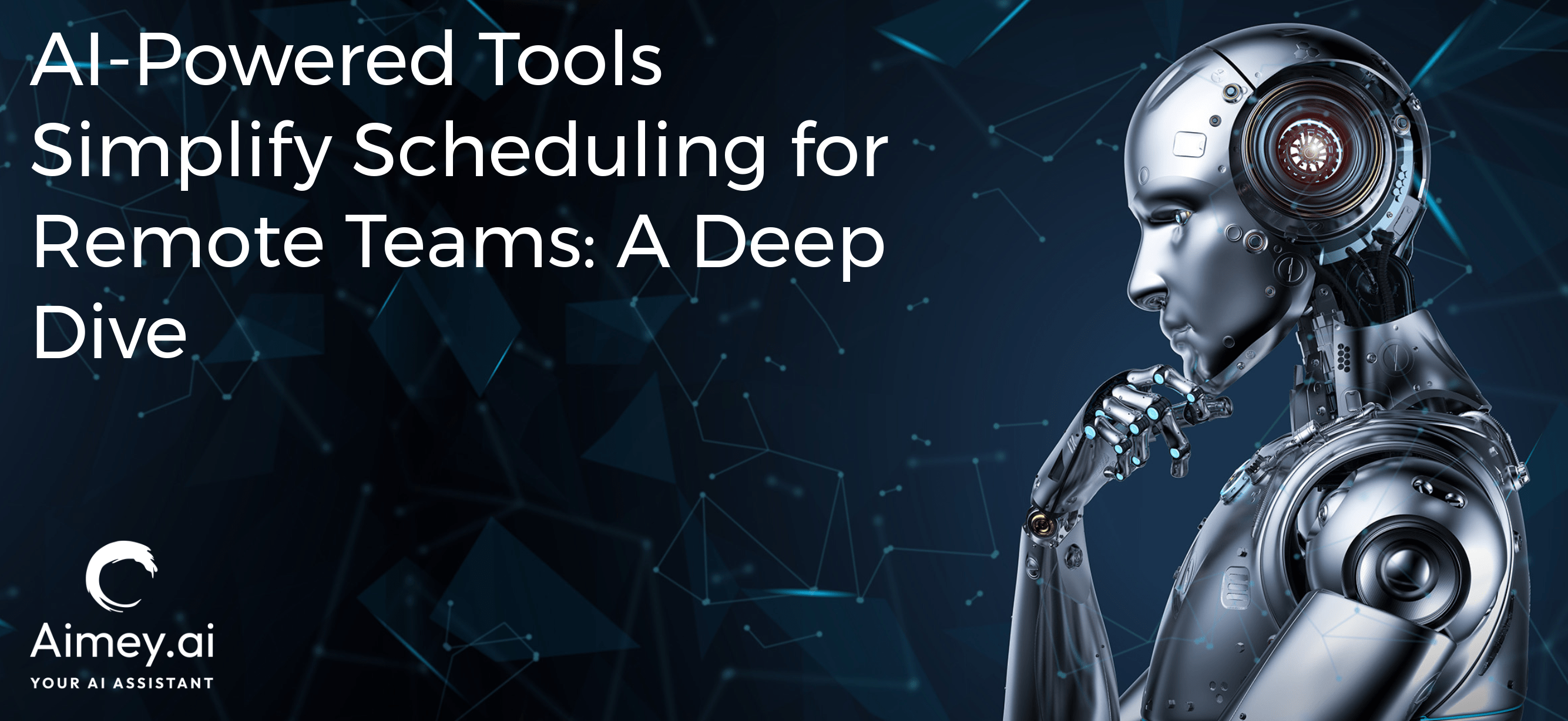Current Challenges in Scheduling for Remote Teams
In today’s fast-paced digital era, remote teams are a staple in diverse business sectors. While remote work presents numerous benefits, it also brings significant scheduling challenges. As companies span different time zones, finding overlapping working hours can be a Herculean task. Besides differing time zones, varied personal schedules, and the lack of physical presence add to the complexity. These factors amplify the need for advanced solutions, as manual scheduling often leads to inefficiencies and missed deadlines. This is where AI-powered tools simplify scheduling for remote teams and enable seamless coordination among members.
Necessity for Smart Solutions
Given the challenges mentioned, the necessity for smarter solutions is evident. Remote teams necessitate precision, flexibility, and real-time adjustments in their schedules. Traditional methods, such as manual calendar entries or basic scheduling software, frequently fall short, mostly due to their inability to adapt dynamically to evolving situations. Accurate schedules that account for the complexities of different time zones, workloads, and priorities are crucial. The advent of AI-powered tools is revolutionizing the approach to these challenges by providing highly adaptive, real-time scheduling solutions that cater to the unique needs of remote teams.
Introduction to AI-Powered Tools
Artificial Intelligence (AI) is paving the way for a new era in scheduling and time management. AI-powered tools leverage sophisticated algorithms to understand patterns, preferences, and constraints in scheduling. These tools are designed to predict the best possible times for meetings, ensure optimal workload distribution, and provide actionable insights into team productivity. AI-driven scheduling solutions are not just about setting up a meeting; they encompass an extensive range of functions from time zone conversions to automatic rescheduling based on real-time changes. Deploying these AI tools equips remote teams with the agility and efficiency required to thrive in our digital landscape.
In-Depth Look at AI in Scheduling
The rapid advancement of AI technology has significantly transformed the workflow of remote teams. AI algorithms are designed to process vast amounts of data and make intelligent decisions based on patterns and insights. In the context of scheduling, AI can analyze calendars, time zones, and team member availability to provide optimal meeting times. As a result, administrative tasks that previously took hours can now be handled in minutes, leading to increased efficiency and productivity.
Key Benefits of AI-Powered Tools for Remote Teams
AI-powered tools simplify scheduling for remote teams, bringing about numerous distinct advantages. First, these tools minimize scheduling conflicts by automatically detecting and resolving potential overlaps. This ensures that meetings are set up at times that are convenient for everyone involved.
Second, AI tools can learn from past behavior. This means that the system becomes more efficient over time by recognizing individual preferences, work habits, and optimal productivity periods. Consequently, the more a team uses these tools, the more effective they become.
Additionally, real-time updates and notifications offered by these tools keep everyone on the same page. For instance, if a meeting time changes or is canceled, the system automatically updates all participants and calendar entries, ensuring no one misses important updates.
Case Study – Impact of AI Tools on Remote Scheduling
Let’s look at a real-world scenario to understand the profound impact of AI tools on remote scheduling. A mid-sized tech company, working across multiple time zones, was struggling with coordination due to constant scheduling conflicts and missed deadlines. After integrating AI-powered solutions, the team’s productivity skyrocketed. Not only were meetings scheduled more efficiently, but the alignment of team tasks also improved.
With AI tools, all team members received suggestions for optimal meeting times and workload distribution. As a result, the company saw a 30% reduction in scheduling conflicts and a 20% increase in meeting attendance rates. Here’s a quick summary of the improvements:
- Reduction in scheduling conflicts by 30%
- Increase in meeting attendance by 20%
- Enhanced task alignment and productivity
- Streamlined communication and real-time updates
These significant improvements highlight how AI-powered tools simplify scheduling for remote teams and enhance overall workflow management.
Did you know that AI-powered scheduling tools use machine learning to optimize meeting times for remote teams across different time zones, leading to a 40% increase in scheduling efficiency?
Embracing the Future of Remote Team Scheduling with AI
The landscape of remote work is rapidly evolving, and the integration of AI-powered tools is setting the stage for a transformative shift in how we approach scheduling and time management. AI tools are not just a convenience – they are becoming a necessity for remote teams striving to operate efficiently and seamlessly across different time zones and geographical boundaries. With the ability to adapt and learn from patterns, AI is bringing a new level of intelligence and responsiveness to our scheduling processes.
Seamless Integration of AI-Powered Tools
Integrating AI-powered tools into your remote team’s workflow can substantially elevate productivity and coordination. Begin with a clear understanding of your team’s scheduling challenges and select AI solutions that specifically address those issues. Tools like aimey.ai make this transition smoother by offering user-friendly interfaces and comprehensive support to ensure team members can adapt quickly. Regular training and feedback sessions will also help in refining the use of these tools, ensuring they cater perfectly to your team’s needs.
Transformative Potential of AI in Team Collaboration
The implementation of AI-powered tools like those offered by aimey.ai goes beyond merely scheduling meetings. These tools provide robust analytics that can forecast potential scheduling conflicts, optimize workload distribution, and even suggest the most productive times for various tasks. By automating these aspects, we free up time and mental energy to focus on more strategic and creative endeavors, enhancing overall team performance.
Final Thoughts on Revolutionizing Remote Team Scheduling
As we delve deeper into the digital era, AI-powered tools simplify scheduling for remote teams by providing innovative solutions that address the unique challenges of remote work. They not only streamline the coordination process but also foster a more cohesive and efficient work environment. By embracing these technologies, we are not just keeping pace with the future; we are shaping a more organized and productive future for remote teams worldwide.
FAQ
How do AI-powered scheduling tools adapt to the various needs of remote teams?
AI-powered scheduling tools like aimey.ai are designed with sophisticated algorithms that learn from user behavior and scheduling patterns within your team. Consequently, our tools tailor their functionalities to accommodate different work styles and preferences, ensuring a harmonious scheduling process that reflects the personal and professional nuances of each team member. This level of personalization fosters a more efficient and intuitive scheduling system that resonates with the unique rhythm of your remote team’s operations.
What are the main advantages of using AI-powered tools for remote team scheduling?
The integration of AI into scheduling tools presents a plethora of advantages, including automated conflict resolution, predictive analytics for workload management, and optimized suggestions for meeting times. Furthermore, these tools significantly reduce the administrative burden of manual scheduling, allowing team members to reallocate their focus to core activities that drive the team’s success. Ultimately, the use of AI in scheduling enhances team coordination, improves productivity, and contributes to a more balanced workload distribution.
Can AI tools adjust to different time zones for global remote teams?
Yes, AI-powered tools are particularly adept at managing the complexities of global remote teams operating across multiple time zones. These smart solutions seamlessly calculate optimal meeting times, ensuring that no team member is disadvantaged by inconvenient scheduling. Moreover, by keeping track of each individual’s location and preferred working hours, AI assists in fostering a respectful and considerate working environment that values every member’s time and contributes to a more cohesive team dynamic.
How can remote teams ensure a smooth transition to AI-powered scheduling tools?
To ensure a smooth transition, remote teams should begin by selecting an AI-powered scheduling tool that aligns with their specific needs. Once a tool like aimey.ai is chosen, it is crucial to provide comprehensive training and support to all team members. This paves the way for proper utilization and maximizes acceptance and efficiency. Regular check-ins and adaptation periods are equally important, as they allow the team to provide feedback and adjust the tool’s settings to better suit their working rhythm. This gradual and supportive approach facilitates a seamless adaptation to AI-powered scheduling tools.
What does the future hold for remote team scheduling with the incorporation of AI?
As we look towards the future, AI is poised to become an indispensable aspect of remote team scheduling. With the ability to enhance real-time decision-making, provide dynamic scheduling solutions, and predict future scheduling needs, AI is shaping a more agile and responsive work environment. The continuous evolution of AI technologies will likely introduce even more sophisticated capabilities, ensuring that remote teams can stay ahead of the curve and maintain high levels of productivity and collaboration in an ever-changing global landscape.

